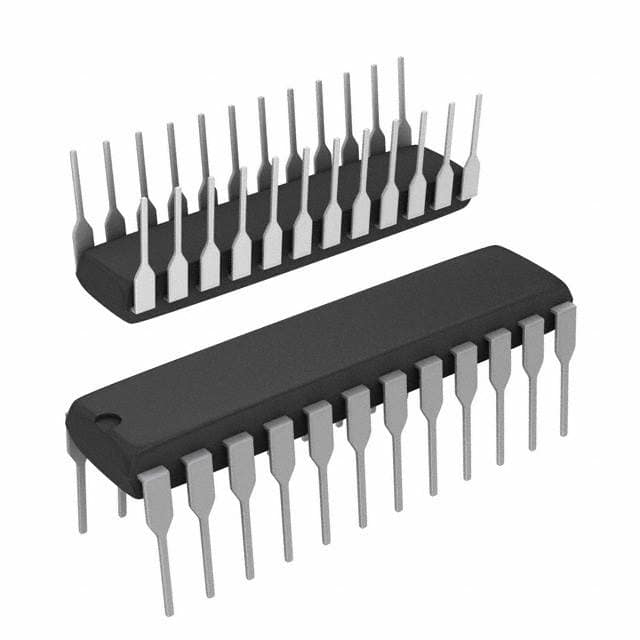Xem thông số kỹ thuật để biết chi tiết sản phẩm.

74F646SPC
Product Overview
- Category: Integrated Circuit (IC)
- Use: Data Bus Transceiver
- Characteristics: High-speed, bidirectional data transfer, voltage level translation
- Package: 20-pin Small Outline Package (SOIC)
- Essence: Facilitates communication between different parts of a digital system
- Packaging/Quantity: Available in reels of 250 units
Specifications
- Supply Voltage: 4.5V to 5.5V
- Operating Temperature: -40°C to +85°C
- Data Rate: Up to 100 Mbps
- Number of Channels: 8
- Input/Output Compatibility: TTL/CMOS
Detailed Pin Configuration
- A0: Address Input 0
- A1: Address Input 1
- A2: Address Input 2
- OE: Output Enable
- DIR: Direction Control
- GND: Ground
- B0: Data Bus B Bit 0
- B1: Data Bus B Bit 1
- B2: Data Bus B Bit 2
- B3: Data Bus B Bit 3
- B4: Data Bus B Bit 4
- B5: Data Bus B Bit 5
- B6: Data Bus B Bit 6
- B7: Data Bus B Bit 7
- VCC: Supply Voltage
- A7: Address Input 7
- A6: Address Input 6
- A5: Address Input 5
- A4: Address Input 4
- A3: Address Input 3
Functional Features
- Bidirectional data transfer between two data buses
- Automatic direction control based on DIR pin
- Output enable/disable control using OE pin
- Voltage level translation between TTL and CMOS logic levels
- High-speed operation for efficient data transfer
Advantages
- Simplifies data communication in digital systems
- Supports high-speed data transfer up to 100 Mbps
- Provides bidirectional data flow with automatic direction control
- Enables voltage level translation between different logic families
- Compact package size allows for space-efficient designs
Disadvantages
- Limited number of channels (8)
- Requires careful consideration of input/output compatibility
Working Principles
The 74F646SPC is a data bus transceiver that facilitates bidirectional data transfer between two data buses. The direction of data flow is controlled by the DIR pin, while the OE pin enables or disables the output. This IC also performs voltage level translation, allowing seamless communication between different logic families such as TTL and CMOS. It operates at high speeds, ensuring efficient data transfer within digital systems.
Detailed Application Field Plans
- Interfacing microcontrollers with external memory modules
- Connecting peripheral devices to a central processing unit (CPU)
- Data communication between different subsystems within a digital system
- Integration into communication protocols like I2C or SPI
Alternative Models
- SN74LVC245APW: Octal Bus Transceiver with 3-State Outputs
- CD74HCT245E: Octal Bus Transceiver with 3-State Outputs
- MC74VHC245DT: Octal Bus Transceiver with 3-State Outputs
(Note: These alternative models may have slightly different specifications and pin configurations. Refer to their respective datasheets for detailed information.)
Word count: 320 words
Liệt kê 10 câu hỏi và câu trả lời thường gặp liên quan đến ứng dụng 74F646SPC trong giải pháp kỹ thuật
Sure! Here are 10 common questions and answers related to the application of 74F646SPC in technical solutions:
Q: What is the 74F646SPC? A: The 74F646SPC is a type of integrated circuit (IC) commonly used as a bus transceiver and register in technical solutions.
Q: What is the purpose of the 74F646SPC? A: The 74F646SPC is designed to facilitate bidirectional data transfer between two buses with different voltage levels or protocols.
Q: What voltage levels does the 74F646SPC support? A: The 74F646SPC typically supports voltage levels ranging from 2.5V to 5V, making it compatible with a wide range of systems.
Q: How many data lines can the 74F646SPC handle? A: The 74F646SPC can handle up to 8 data lines, allowing for parallel transfer of data between buses.
Q: Can the 74F646SPC be used in both synchronous and asynchronous applications? A: Yes, the 74F646SPC can be used in both synchronous and asynchronous applications, providing flexibility in various technical solutions.
Q: Does the 74F646SPC require external components for operation? A: Yes, the 74F646SPC typically requires external resistors and capacitors to set the voltage levels and control the timing characteristics.
Q: What is the maximum operating frequency of the 74F646SPC? A: The maximum operating frequency of the 74F646SPC depends on various factors but is typically in the range of tens to hundreds of megahertz.
Q: Can the 74F646SPC handle bus arbitration or prioritization? A: No, the 74F646SPC is primarily designed for data transfer and does not include built-in features for bus arbitration or prioritization.
Q: Is the 74F646SPC compatible with other common IC families? A: Yes, the 74F646SPC is generally compatible with other TTL (Transistor-Transistor Logic) families, making it versatile in many technical solutions.
Q: Are there any specific precautions to consider when using the 74F646SPC? A: It is important to carefully review the datasheet and application notes provided by the manufacturer to ensure proper usage and avoid potential issues related to voltage levels, timing, and signal integrity.
Please note that the answers provided here are general and may vary depending on specific implementation details and requirements.

